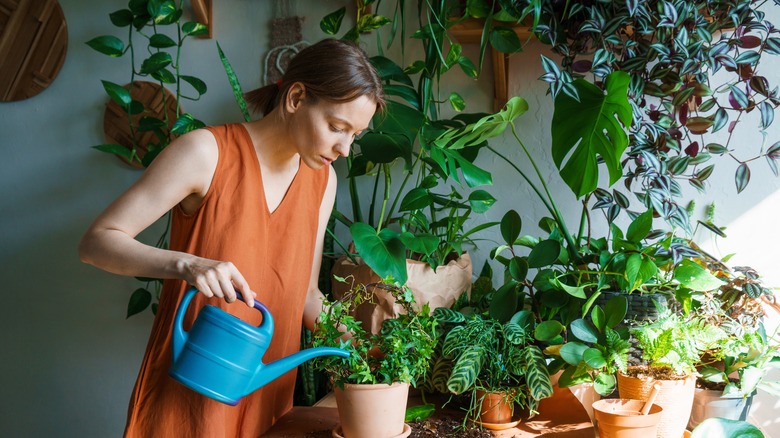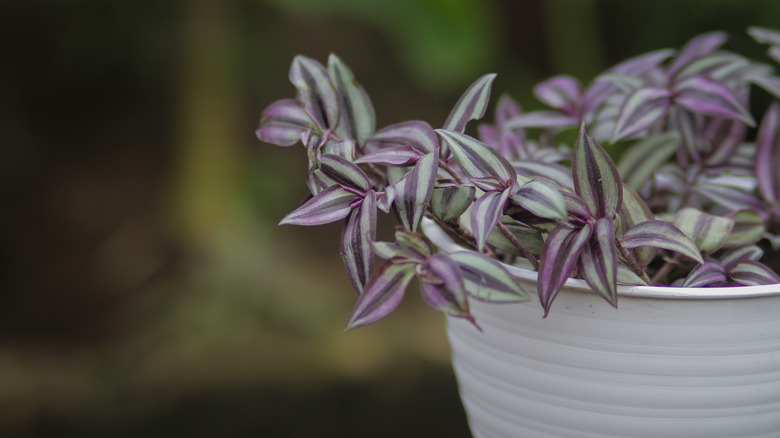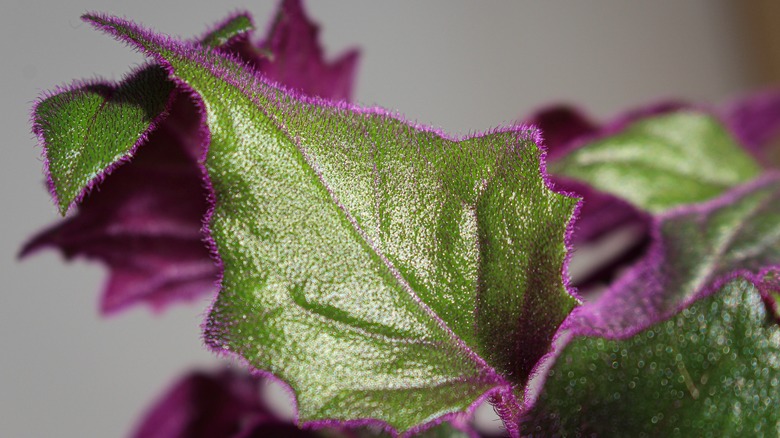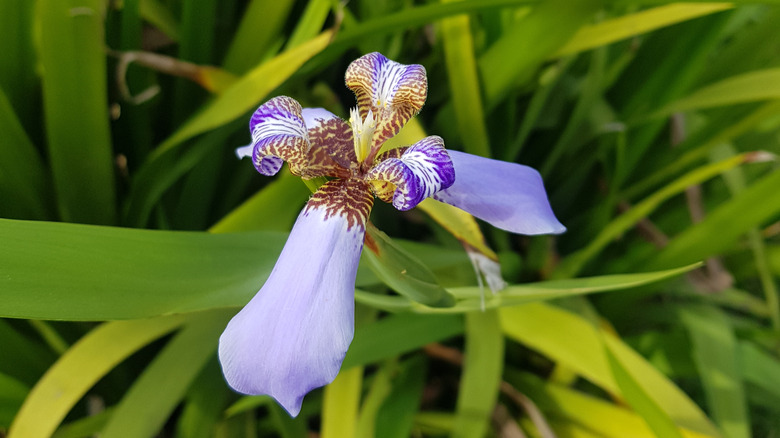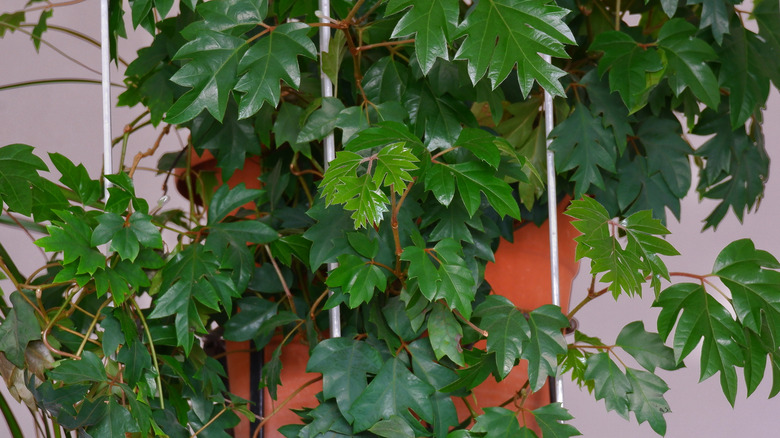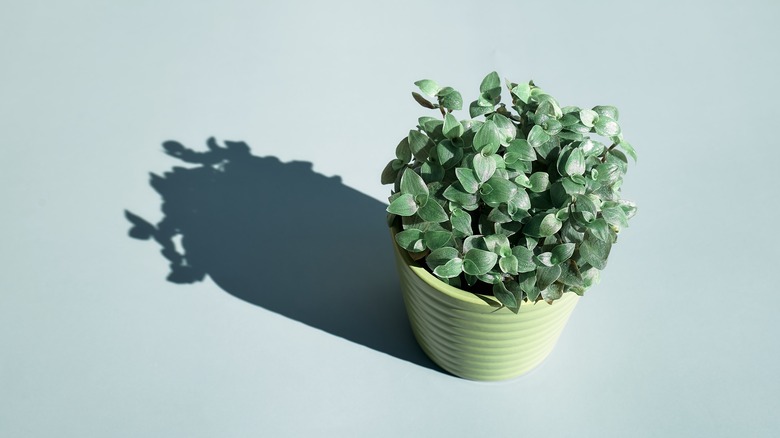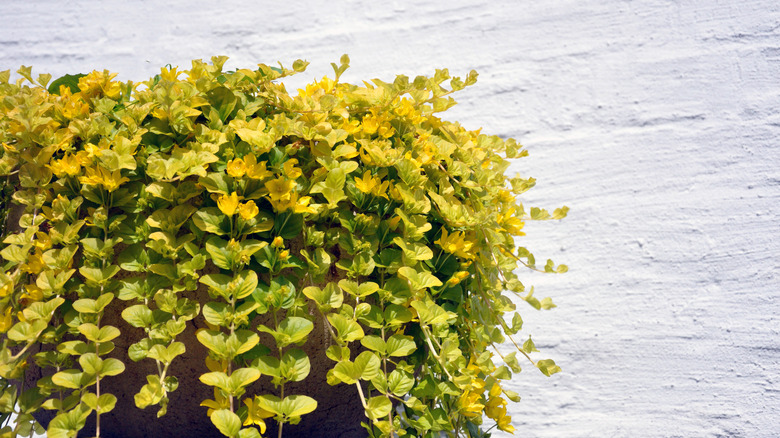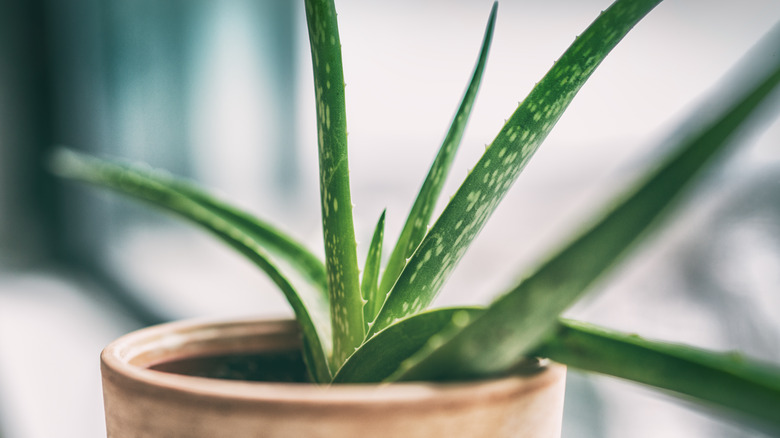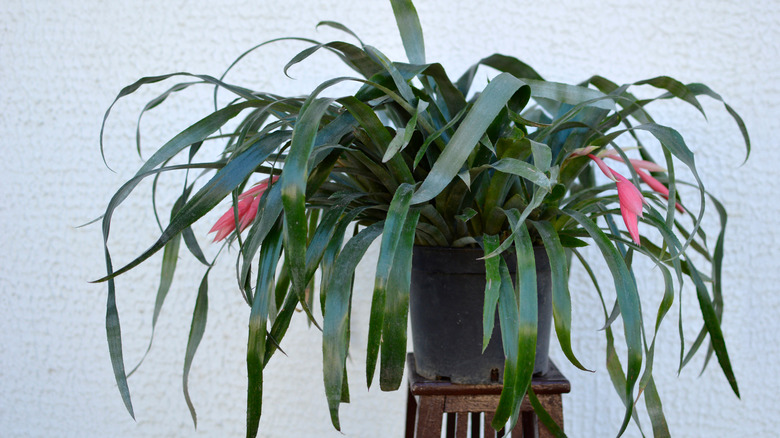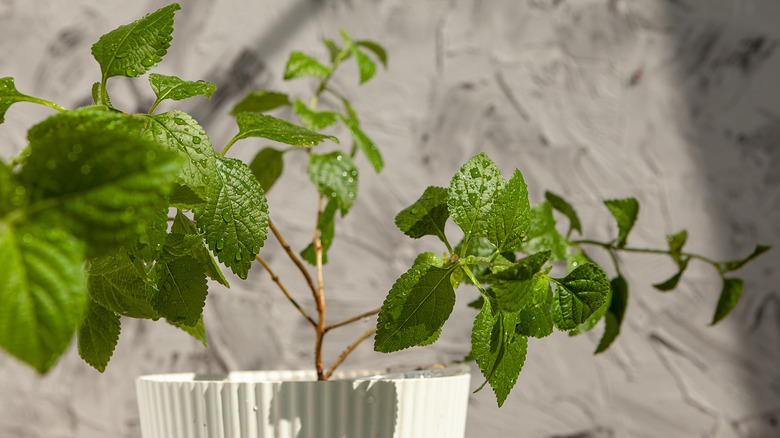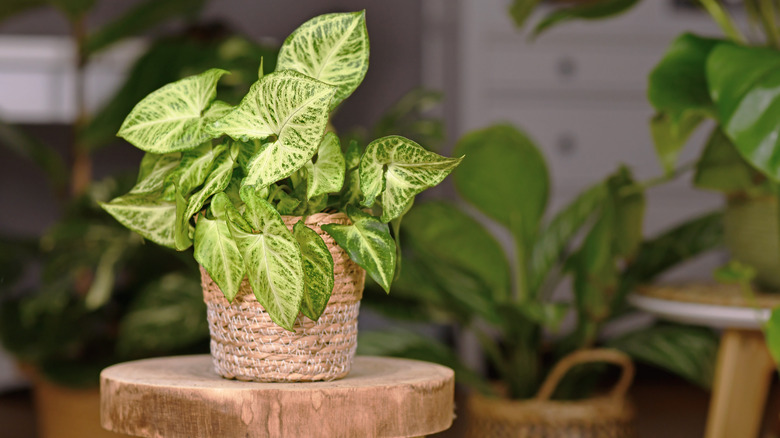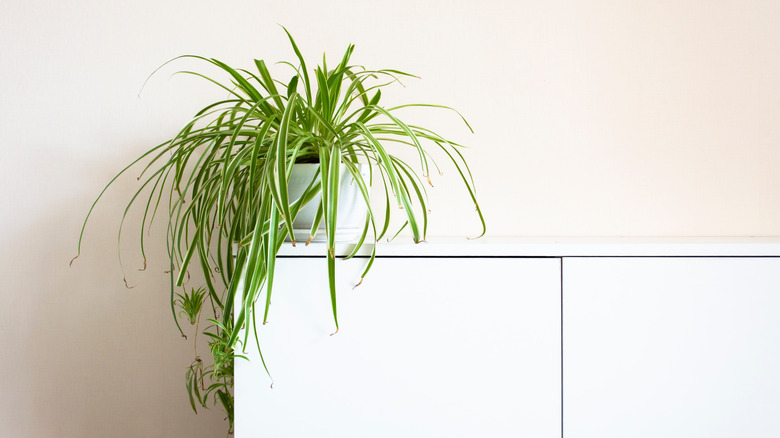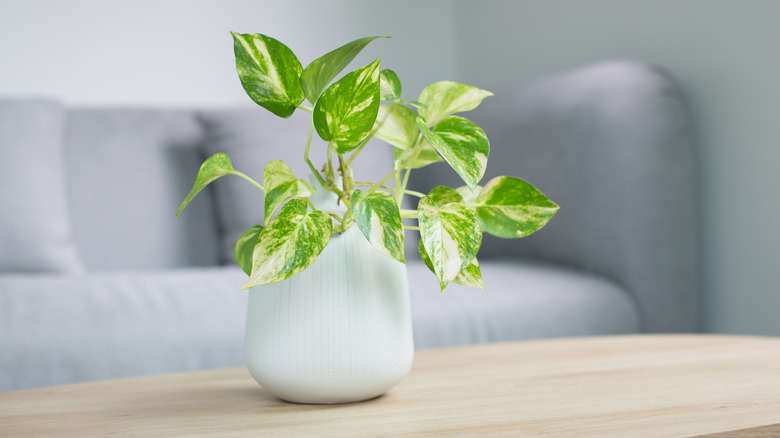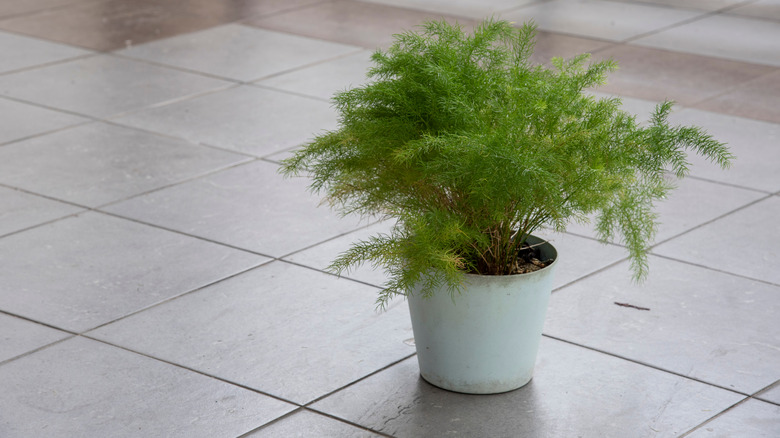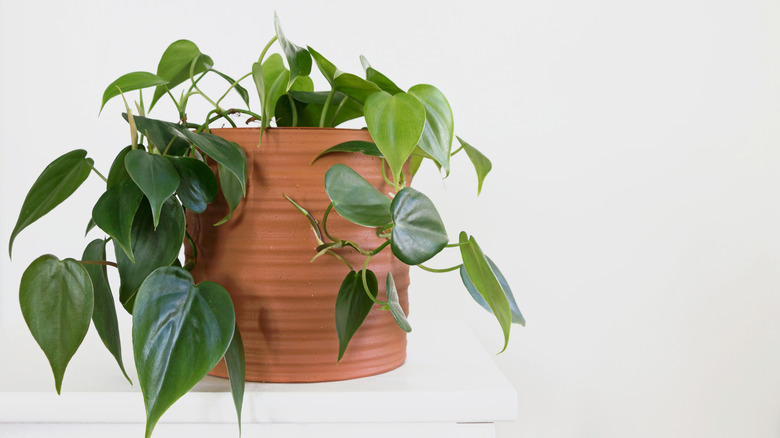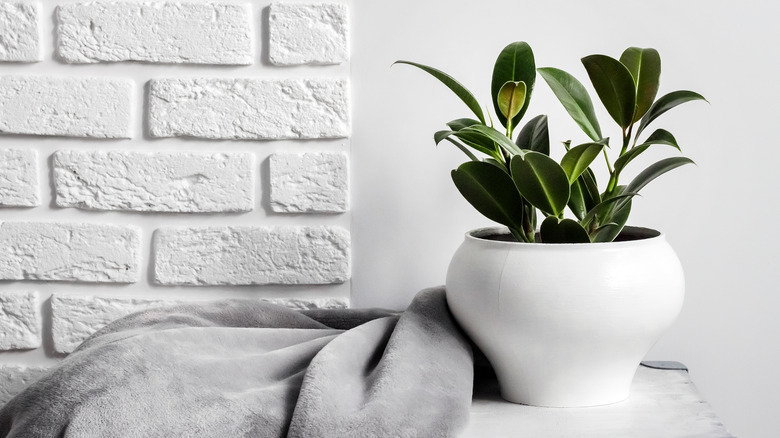15 Fast-Growing Houseplants To Make Your Interior Space Lush And Green
Growing houseplants can be tedious and frustrating when you nurture varieties such as Jade, Cast Iron, or ZZ plants. These slow-growers will eventually become gorgeous, mature specimens, but you'll have to wait a long time before seeing any significant changes. If you are looking for plants that will give you an instant indoor garden, you'll need to look further. There are countless plants ready to show off their vigorous growth and vibrant green foliage after they are provided with the right indoor conditions.
When you are working on building your fast-growing houseplant collection, you should keep in mind that even the plants with the quickest growth habits typically have dormant periods during the fall or winter. As explained by Salisbury Greenhouse, nearly all plants grow more quickly during their growing season in the spring and summer when they receive lots of light, water, and fertilizer. Still, you can take advantage of this cycle by choosing your favorite plants from this list that present you with abundant growth when cared for the right way.
1. Zebra plant
The zebra plant (Tradescantia zebrina) is an excellent option for the impatient gardener. It features thick, variegated foliage that looks its best when the plant is placed in bright indirect lighting, as per the University of Wisconsin-Madison Division of Extension. Overall, the zebra plant is relatively low-maintenance, and it does well as a container plant when grown indoors.
Bloom Season: Rarely blooms indoors
USDA Growing Zone: 9 to 11
Growing Conditions: Bright indirect light
Soil Type: Well-drained potting mix
Size: 6 to 12 inches tall, up to 2 feet wide
2. Purple passion plant
Purple passion plants (Gynura aurantiaca) are herbaceous perennials that produce yellow to orange flowers. However, these flowers are known to smell very unpleasant, so they are often removed quickly, as explained by the North Carolina Extension Gardener Plant Toolbox. To keep the purple passion plant from blooming, you can grow it in low light conditions, but it can lead to duller leaves.
Bloom Season: Fall and winter
USDA Growing Zone: 10 to 12
Growing Conditions: Bright, medium, or low indirect light
Soil Type: Well-drained potting mix
Size: 1 to 2 feet tall and 2 to 4 feet wide
3. Walking iris
The walking iris plant (Neomarica northiana) is an evergreen flowering plant known for its fragrant flowers that bloom only once. The walking iris' blooming period is short, but the plant has ornamental value year-round due to its arching green leaves, according to San Marcos Growers.
Bloom Season: Spring and summer
USDA Growing Zone: 9 to 10
Growing Conditions: Bright indirect light
Soil Type: Well-drained potting mix
Size: 2 to 3 feet tall and 1 to 2 feet wide
4. Grape Ivy
The grape ivy (Cissus alata) is a fast-growing plant known for its ability to grow in poor conditions like low humidity and medium light, says the North Carolina Extension Gardener Plant Toolbox. The perennial vine can be identified by its glossy green leaves and climbing habit, and it looks great in hanging baskets or pots when hung high on shelving units.
Bloom Season: Blooms throughout the year
USDA Growing Zone: 10 to 12
Growing Conditions: Bright to medium indirect light
Soil Type: Well-drained potting mix
Size: 6 to 10 feet tall, 3 to 6 feet wide
5. Turtle vine
Turtle vines (Callisia repens) are small trailing houseplants that require little maintenance. Unfortunately, as warned by Woodies Garden Goods, the plant is toxic to pets and humans but does well in hanging planters that keep it out of reach from Fluffy and little Johnny. There are a few cultivars of turtle vines with different features. For example, the 'Bianca' variety has gorgeous variegated pink and green foliage.
Bloom Season: Summer
USDA Growing Zone: 9 to 11
Growing Conditions: Bright indirect light
Soil Type: Well-drained potting mix
Size: Up to 1 foot tall and wide
6. Moneywort
Moneywort plants (Lysimachia nummularia) are a species of low-growing, ornamental plants with quick-growing stems. Though it is often used as ground cover, the flowering creeper also grows nicely in containers and hanging baskets, as told by the University of Wisconsin-Madison Division of Extension. In the right conditions, this plant may produce small yellow flowers that usually blend in with its foliage.
Bloom Season: Summer to fall
USDA Growing Zone: 3 to 9
Growing Conditions: Bright direct or indirect light
Soil Type: Moist potting mix
Size: 3 to 6 inches tall, 12 to 18 inches wide
7. Aloe plant
The Aloe plant (Aloe barbadensis) is a common succulent grown indoors and outdoors. As a fast-growing plant, the size can be challenging to control outdoors; however, its indoor plant growth can be restrained by the size of its container, as taught by the University of Florida IFAS Gardening Solutions. If you're looking for a versatile houseplant, aloe is a great option.
Bloom Season: Late winter to spring
USDA Growing Zone: 8 to 11
Growing Conditions: Bright direct or indirect light
Soil Type: Well-draining potting mix
Size: Up to 2 feet tall, up to 1 foot wide
8. Queen's tears
The queen's tears plant (Billbergia nutans) is a member of the Bromeliad family, which also includes pineapples, urn plants, and earth stars. The plant can be identified by its colorful hanging flowers, which give the epiphytic bromeliad its name. It also features green arching leaves and stems, as described by San Marcos Growers.
Bloom Season: Spring
USDA Growing Zone: 8 to 11
Growing Conditions: Bright to medium indirect light
Soil Type: Well-drained, organically rich potting mix
Size: 1 to 2 feet tall and wide
9. Swedish Ivy
Swedish Ivy plants (Plectranthus australis), also called Cuban oregano, are herbaceous perennials native to South Africa. This vigorously growing plant can quickly reach 3 feet tall with stems that show off wide, glossy green leaves that are sometimes variegated depending on the cultivar, according to the Missouri Botanical Garden.
Bloom Season: Blooms throughout the year
USDA Growing Zone: 10 to 11
Growing Conditions: Bright direct or indirect light
Soil Type: Well-drained, hummus potting mix
Size: 2 to 3 feet tall and wide
10. Arrowhead plant
Arrowhead plants (Syngonium podophyllum) are evergreen climbers that can grow up to 7 feet tall when provided with proper care. It is named after its arrow-shaped leaves that are veined with a light-green to white color. As per The Royal Horticultural Society, when growing an arrowhead plant, you should be wary of its toxic leaves, stems, flowers, and roots which can irritate your hands and eyes.
Bloom Season: Summer
USDA Growing Zone: 10 to 12
Growing Conditions: Bright indirect light
Soil Type: Well-drained potting mix
Size: Up to 7 feet tall, 2 to 6 inches wide
11. Spider plant
Spider plants (Chlorophytum comosum) are a great addition to any houseplant collection that could use a little more foliage variation. The spider plant is known for its thin, arching leaves, which can be light-green, dark-green, yellow, or white depending on the cultivar, as mentioned by the University of Wisconsin-Madison Division of Extension.
Bloom Season: Spring and summer
USDA Growing Zone: 9 to 11
Growing Conditions: Bright to medium indirect light
Soil Type: Well-drained potting mix
Size: Up to 1 to 2 feet tall and wide
12. Pothos plant
Also known as Devil's Ivy, pothos plants (Epipremnum aureum) are some of the fastest growing and easiest to care for houseplants. This climbing plant has aerial roots and heart-shaped leaves. It's truly an excellent houseplant that you can't go wrong with when building your collection.
Bloom Season: Does not flower
USDA Growing Zone: 10 to 12
Growing Conditions: Bright, medium to low indirect light
Soil Type: Well-drained potting mix
Size: 6 to 10 feet long when container-grown, 3 to 6 feet wide
13. Asparagus fern
The asparagus fern (Asparagus setaceus plumosus) is an indoor plant that appears bushy at first but quickly becomes taller and more spindly, explains RHS Plants. Technically, the asparagus fern is not a fern at all but a perennial herb that looks somewhat like a fern. The herb appears fluffy at maturity due to its small leaves tightly packed together on its stems.
Bloom Season: Spring to fall
USDA Growing Zone: 9 to 11
Growing Conditions: Bright indirect light
Soil Type: Well-drained potting compost mix
Size: Up to 10 feet tall and 3 feet wide
14. Philodendron
Philodendron (Philodendron hederaceum) is likely a plant name you've heard repeatedly. This plant is recommended for all kinds of uses, including in hanging baskets, vertical spaces, and bedroom plantings. As said by the North Carolina Extension Gardener Plant Toolbox, the philodendron plant is a resilient plant that tolerates poor growing conditions with ease. It is perfect for beginner, impatient, and neglectful gardeners.
Bloom Season: Spring and summer
USDA Growing Zone: 10 to 11
Growing Conditions: Bright indirect light
Soil Type: Well-drained potting mix
Size: 4 inches to 6 feet long, 20 to 26 inches wide
15. Rubber fig
Rubber fig plants (Ficus elastica) adapt well to many conditions while growing quickly. They have few problems and are hard to kill. The main issue you'll want to avoid, as the Clemson Cooperative Extension recommended, is overwatering and underwatering. The rubber plant is susceptible to root rot and leaf yellowing.
Bloom Season: Spring and summer
USDA Growing Zone: 10 to 11
Growing Conditions: Bright, medium to low indirect light
Soil Type: Well-drained potting mix
Size: 6 to 10 feet tall
